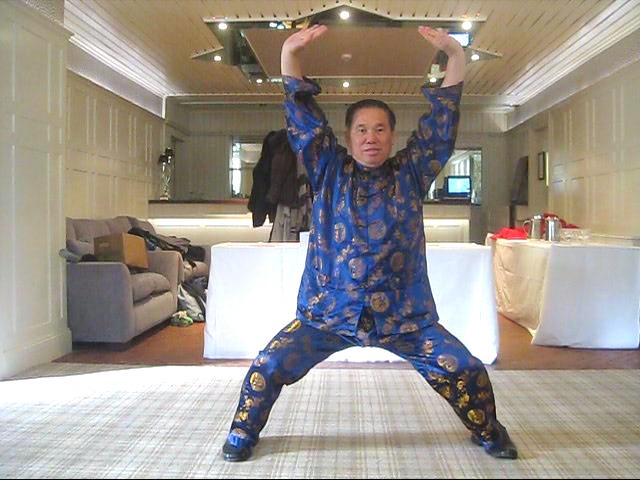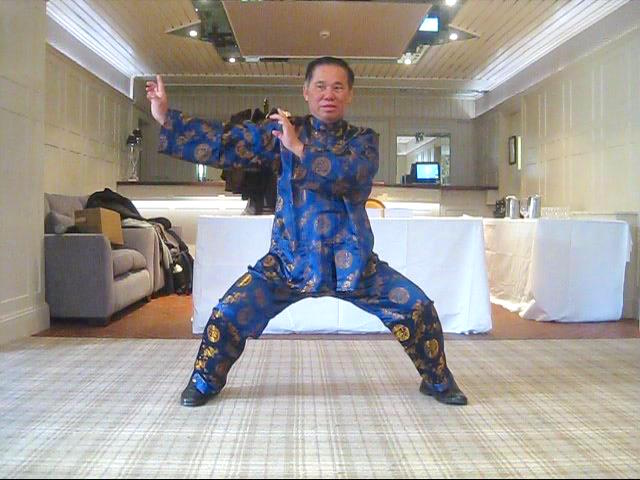HOW IS IRON WIRE IN SHAOLIN WAHNAM DIFFERENT FROM THE ESTABLISHED ONE?

Big Boss Lifts Bronze Vessel
Question
It seems from the information available to us on the Iron Wire Set that Patriarch Tit Kiew Sam personally composed it as a crystallization of his extensive internal force training and experience.
The set that you have been so kind to share with us seems similar to the spirit of Patriarch Tit Kiu Sam's Iron Wire, in that it (to the best of my understanding) combines and crystallises your intensive experience of many useful internal force training methods into a balanced set, building on the established version of Iron Wire taught in Grandmaster Lam Sai Weng's lineage.
In what ways is Iron Wire as practised in our school similar to the Iron Wire of Grandmaster Lam Sai Weng's lineage, and in what ways does it differ? And more importantly, what unique benefits are to be had from practising our modified composition over the established one?
Max
Answer
Yes, the Iron Wire Set was composed by Tit Kiew Sam, the most senior of the Ten Tigers of Canton. His teacher was the Venerable Cheng Chao who learned from the Venerable Sam Tuck, the second most senior disciple of the Venerable Chee Seen, the Patriarch of Southern Shaolin Kungfu.
Although his internal force was tremendous and his fighting experience wide, Tit Kiew Sam did not have extensive internal force training methods. This was the norm. Even great kungfu masters had only one or two methods. The internal force training method of Hoong Hei Khoon, for example, was Triple Stretch, of Yim Wing Choon was Siu Lin Tou, of Huo Yun Jia was Eighteen-Lohan Art, and of Yang Lu Chan was Grasping Sparrow's Tail.
Exceptions were kungfu geniuses like Zhang San Feng, Ng Mui, Pak Mei and Chee Seen who knew many internal force training methods.
The internal force training method which Tit Kiew Sam learned from his sifu was Triple Stretch, which was the specialty of his sigung, the Venerable Sam Tuck. It was from Triple Stretch that Tit Kiew Sam drew his inspiration and method to compose the Iron Wire Set. It was recorded that Tit Kiew Sam was very impressed with the tremendous internal force of his sisookgung, Hoong Hei Khoon, who was then over 80 years old. Tit Kiew Sam sought from his sisookgung the finer points of the Triple Stretch Set.
Yes, the Iron Wire Set we practice in Shaolin Wahnam is based on that taught in Grandmaster Lam Sei Weng's lineage which inherits the Iron Wire Set of Tit Kiew Sam. Grandmaster Lam Sei Weng learned the set from his sifu, Wong Fei Hoong, who in turn learned from Lam Fook Seng. Lam Fook Seng was Tit Kiew Sam's disciple.
You are also right in your observation that I crystallized my experience of many internal force training methods and incorporated them into our version of the Iron Wire Set. Hence, our version of the Iron Wire Set is quite different from that found in Grandmaster Lam Sai Weng's lineage.
The general structure, patterns and force training approach in our version are similar to those in Grandmaster Lam's version. There are, however, three important force training patterns that I introduced into our version and therefore not found in Grandmaster Lam's version.
The first is the signature greeting pattern from my sifu, Sifu Ho Fatt Nam. This signature greeting pattern is also found in the fundamental set practiced at the Southern Shaolin Temple, namely Four Gates. I find this signature greeting pattern extremely useful right at the start as it sets the Small Universe flowing, roots the practitioner firmly onto the ground, and channels his energy through both arms to the index fingers.
The second pattern is "Big Boss Lifts Bronze Vessel" taken from the Eighteen-Lohan Art. This pattern uses the hard approach to develop a lot of internal force, opens the heart, strengthens the kidney system, and roots the practitioner to the ground.
The third pattern is "Left Right Circulating Soft Bridge", taken from my specialty, Dragon Strength Circulating Energy Set. It uses the soft approach to develop internal force, and circulates energy to various parts of the body. Although this pattern is not found in Grandmaster Lam's version it is found in the Tiger Crane Double Form Set of his lineage.
Moreover, although both we and practitioners of Grandmaster Lam's version use the triple-stretch method to develop internal force, our approach is softer.
Thirdly, we pay much importance to energy flow and employ "Flowing Breeze Swaying Willows" after each section as well as at the completion of the set. Practitioners of Grandmaster Lam's version generally do not do this.
Because of the addition of these methods, we have special benefits in our version over the other version. The internal force developed in our version is softer and more flowing. Its application is more versatile and varied. While the internal force of the other version is mainly used for combat, that in our version can be used for combat as well as other purposes, like overcoming pain and illness, promoting good health, vitality and longevity, and for spiritual cultivation.
Because of our chi flow, we are less likely to practice the Iron Wire Set as isometric exercise than in the other version. If we make mistakes in our training, our chi flow can readily clear out the resultant adverse effects. Practitioners of the other version do not have this advantage.
Because of our understanding and experience in chi flow, we can develop internal force right from the start of practicing the Iron Wire Set. Practitioners of the other version have to generate a chi flow first when they practice the Iron Wire Set, and they are often unaware of this process. Only when they have a chi flow, they start to develop internal force. Hence, our development of internal force is faster than that in the other version.
The above question-answer is reproduced from the thread 10 Questions to Grandmaster Wong on the Iron Wire Set in the Shaolin Wahnam Discussion Forum

Right Circulating of Soft Bridge
LINKS
